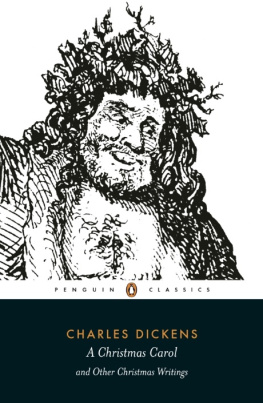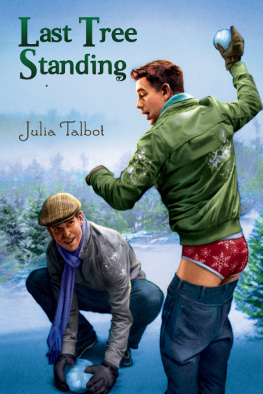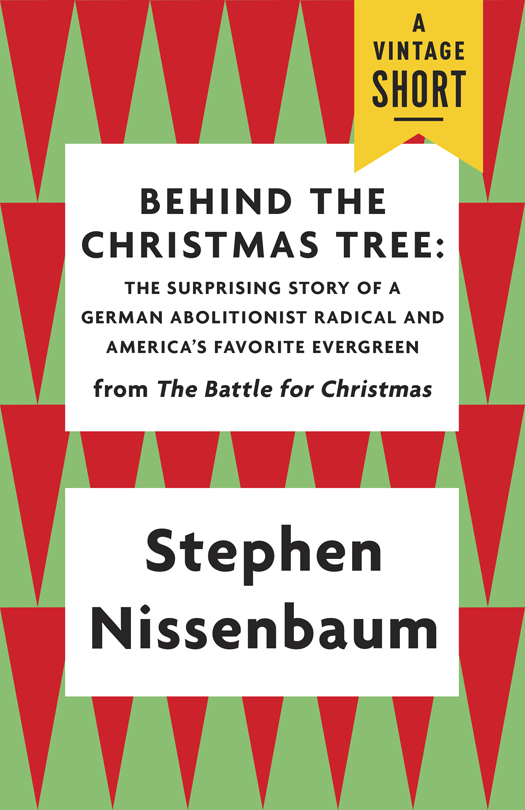Stephen Nissenbaum
Stephen Nissenbaum is professor of history emeritus at the University of Massachusetts at Amherst and adjunct professor of history at the University of Vermont. In addition to The Battle for Christmas (1996), he has written Sex, Diet, and Debility in Jacksonian America (1980) and Salem Possessed: The Social Origins of Witchcraft (1974, coauthored with Paul Boyer and a finalist for the National Book Award as well as winner of the John H. Dunning Prize of the American Historical Association). The Battle for Christmas was a Pulitzer Prize finalist in History.
A LSO BY S TEPHEN N ISSENBAUM
Salem Possessed: the Social Origins of Witchcraft (with Paul Boyer, 1974)
Sex, Diet, and Debility in Jacksonian America: Sylvester Graham and Health Reform (1980)
The Pursuit of Liberty: A History of the American People (with others, 1984, 1990, 1996)
E DITOR
The Great Awakening at Yale College (1972)
Salem-Village Witchcraft: A Documentary Record of Local Conflict in Colonial New England (with Paul Boyer, 1972, 1993)
The Salem Witchcraft Papers: Verbatim Transcripts of the Legal Documents of the Salem
Witchcraft Outbreak of 1692 (with Paul Boyer, 1977)
Nathaniel Hawthorne, The Scarlet Letter and Selected Writings (1984)
Behind the Christmas Tree:
The Surprising Story of a German Abolitionist Radical and Americas Favorite Evergreen
from The Battle for Christmas
by Stephen Nissenbaum
A Vintage Short
Vintage Books
A Division of Random House LLC
New York
Copyright 1996 by Stephen Nissenbaum
All rights reserved. Published in the United States by Vintage Books, a division of Random House LLC, New York, and in Canada by Random House of Canada Limited, Toronto, Penguin Random House companies. Originally published as part of The Battle for Christmas in hardcover in the United States by Alfred A. Knopf LLC, New York, in 1996, and subsequently published in trade paperback by Vintage Books, a division of Random House LLC, New York, in 1997.
Vintage and colophon are registered trademarks of Random House LLC.
The Cataloging-in-Publication Data for The Battle for Christmas is available from the Library of Congress.
Cover design by Joan Wong
Vintage eShort ISBN: 978-1-101-91151-8
www.vintagebooks.com
v3.1
Contents
Little Charleys Christmas Tree
Twas the night before Christmas There is no document about the Christmas tree that corresponds to Clement Clarke Moores verses about Santa Claus. Instead, there are only various legends that describe how the Christmas tree came to America. One of these legends is about Hessian soldiers during the American Revolution (it dates the real event too early); another is about Queen Victoria and her German-born husband, Prince Albert (it dates the event too late).
What is probably the most famous of the legends, and the one with which we shall begin, has it that the first American Christmas tree was set up in Massachusetts, in 1835, by Charles Follen, a German immigrant who had become an American citizen and a Harvard professor. The source of that legend is a popular book written by a very famous British visitor to the United States, a woman named Harriet Martineau, who happened to witness the Follens tree while she was touring New England. As Martineau wrote, I was present at the introduction into the new country of the German Christmas-tree. Though this was not the first American Christmas tree, it is certainly true that Charles Follen set up a Christmas tree in Martineaus presence for his son and namesake, an endearing 5-year-old whom everybody called little Charley. It is time to visit the scene.
The tree (actually the top portion of a fir or spruce) had been placed in the front drawing room of the house. A toy hung from every branch, and when Martineau arrived Charles Follen and his wife were just adding the seven dozen little wax candles. As little Charley and two older companions approached the house, the adults quickly closed the door to the front drawing room and moved into an adjacent room, where (as Martineau put it) they sat around trying to look as if nothing was going to happen. After the visitors were served tea and coffee, a round of parlor games was played in an effort to distract the childrens attention from the front drawing room, where Charleys parents were now busy lighting the candles. (The element of surprise was crucial here.)
Finally, the double doors were thrown open and the children poured in, their voices instantaneously hushed. Their faces were upturned to the blaze, all eyes wide open, all lips parted, all steps arrested. Nobody spoke, only Charley leaped for joy. After a few moments the children discovered that the tree bore something eatable, and the babble began again. The children were told to take what they could from the tree without burning themselves on the candles. (Martineau reported that we tall people kept watch, and helped them with good things from the higher branches.)
After the children had eaten their fill of the edibles, the evening continued with dancing and mugs of steaming mulled wine. By eleven, all the other guests had gone home; little Charley was in bed; and Harriet Martineau herself was left alone with the boys parents, Charles and Eliza Follen. It had been a delightful evening, and Martineau concluded her account by predicting that the Christmas tree ritual would surely become an established American tradition.
KARL FOLLEN S STORY
Harriet Martineaus story of little Charley Follens Christmas tree was accurate enough, even if this was not the first American Christmas tree. But in an important way the story was misleading. For when Martineau reported the episode, she placed it in a context that implied that she had simply stumbled upon it during the course of her travels. The episode appeared as part of a catchall chapter in Martineaus book, a chapter she called Hot and Cold Weather, about seasonal phenomena in New England.
Martineaus evening with the Follens was anything but an accident of travel or part of the ordinary New England seasonal cycle. Martineau and the Follens had met only a few months earlier, but in the course of those few months they had become fast personal friends and political allies in a cause that was changing the course of their lives. Harriet Martineau had gone to visit the Follens that evening to chart their mutual plans at a moment of crisis, a crisis that was forcing them to make a difficult choice between their personal principles and their professional careers. The issue that precipitated the crisis was nothing less than the movement to abolish slavery in America. It is a story worth telling in detail.
I F C HARLES F OLLEN HAD not died in 1840 at the age of 43 (in the explosion of a steamship), he would he would probably be remembered today in connection with something more important than the American Christmas tree. Even as it stands, however, Follens career is fascinating. Like Thomas Paine before him, he was a radical on two continents. Even before coming to America in 1825 in his late twenties, Follen had been exiled from Germany for his revolutionary activities.
Karl Follen, as he was named at birth, studied theology and law as a teenager, earning his doctorate at age 22 and receiving an adjunct faculty position at the University of Jena. But by that time Follen had become politically radicalized, joining an emergent nationalist youth movement that called for an end to the existing aristocracy and the formation of a German electoral republic. Indeed, Follen became a leader of the most extreme wing of that nationalist movement. He called for the exclusion of Jews from citizenship in the future German republic, and he agitated for popular revolution. Employing both legal and theological arguments, Follen insisted that violenceeven political assassinationwas justifiable. In 1819 one of his young followers did just that, murdering a prominent German playwright who had belittled German nationalism. Follen himself was arrested and tried for complicity in the crime (though acquitted for lack of evidence). He soon left Germany first for France, then Switzerland. Forced to flee again in 1824 in the face of new charges from Germany, Follen finally found refuge in America. Learning English on the voyage, he arrived bearing letters of introduction from another European revolutionary, the aged Marquis de Lafayette, who had suggested that he seek employment in the Boston area.









